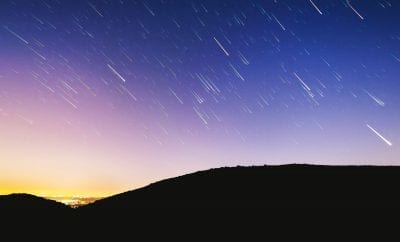Entertainment & Events
Where to watch the Perseid meteor shower on Aug. 12-13
For information on the 2015 Perseid meteor shower, click here.
 The Perseid meteor shower, an annual event that is visible for a few weeks in the late summer sky, will be lighting up the night sky. In San Diego and the rest of California, the best times will be from Aug. 12-13 around 6:30 a.m., or the early the dawn hours (in the East it will be around 12:30 p.m.). The meteor will appear to be showering from the constellation Perseus in the Northeastern sky
The Perseid meteor shower, an annual event that is visible for a few weeks in the late summer sky, will be lighting up the night sky. In San Diego and the rest of California, the best times will be from Aug. 12-13 around 6:30 a.m., or the early the dawn hours (in the East it will be around 12:30 p.m.). The meteor will appear to be showering from the constellation Perseus in the Northeastern sky
The Perseid meteor shower is named after the constellation Perseus, which is located in roughly the same point of the night sky where the Perseid meteor shower appears to originate from. This meteor shower is the product of the debris from the comet Swift-Tuttle. Every year, the Earth passes through the debris cloud left by the comet when the debris burns up while passing through Earth’s atmosphere, resulting in beautiful streaks of light.
Because of the way the earth hits this debris cloud, the Perseid meteor shower is much more visible in the Northern hemisphere. People in Canada, typically see the meteor shower by mid-July, and in Europe, the US and the rest of North America, meteor shower activity usually peaks sometime around August 12th, when it is not unusual to see at least 60 meteors per hour streaking across the Northeastern sky.
Be prepared to see something bright, but look closely, or through a telescope since they are super tiny objects, usually no larger than a grain of sand. They travel at speeds of 71 kilometers per second and have been observed as long ago as 2,000 years. In ancient Europe, the Perseid meteor shower was known as the “Tears of St. Lawrence.”
So, where should you plant yourself to see this wondrous site?
The best place is somewhere dark, away from light pollution, and with the moon out of your field of vision. The less light visible, the more brilliant the meteor shower will be. Try driving out to Alpine or Julian or the desert for the best view. For a particularly spectacular view, head out to Mt. Laguna. If you cannot make it that far, a great place to gaze at the sky is the top of Mt. Soledad.
You can certainly watch with your naked eye, but binoculars or a camera with a telescopic lens may make the meteor shower clearer. For photographing purposes, you can use a digital camera mounted on a Tripod and shoot quick as if you were photographing a fashion show! You’re bound to get at least one this way.
Photo from navicore via Flickr.




1 Comment